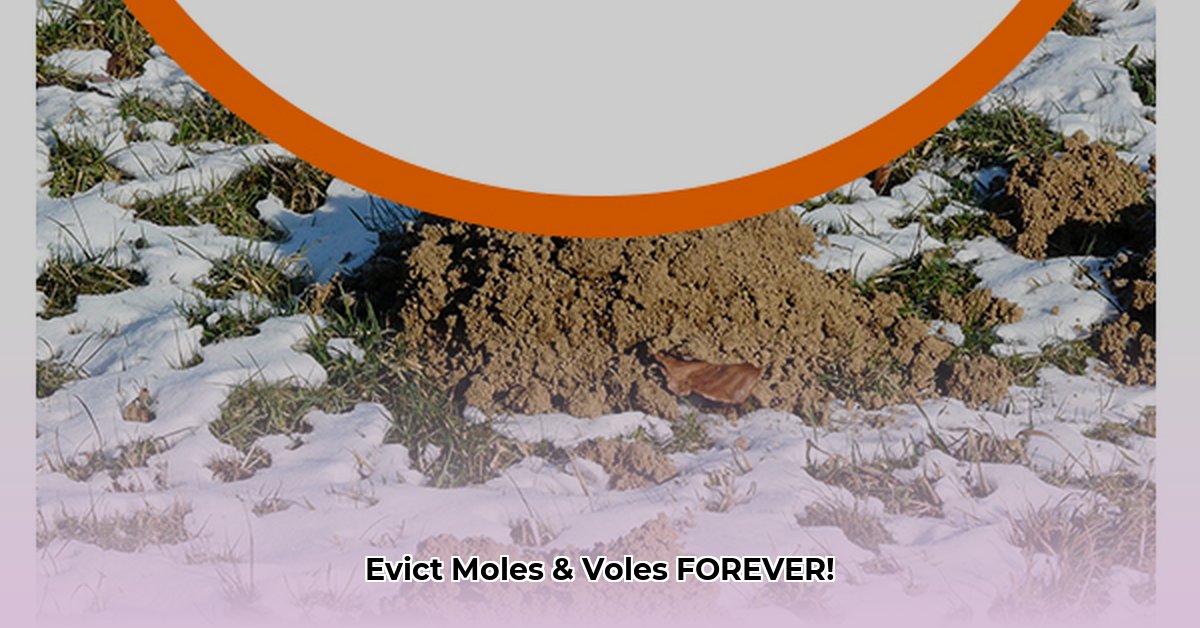Got uninvited guests digging up your yard? Voles and moles can wreak havoc, but this guide offers solutions for getting rid of them for good. We’ll cover identification, control strategies, and long-term prevention, so you can reclaim your garden.
Identifying the Culprits: Vole vs. Mole
Knowing your enemy is the first step. Moles are insectivores, digging deeper tunnels marked by raised ridges and volcano-shaped molehills. Voles, on the other hand, are plant-eating rodents that create surface runways and small burrow entrances.
Mole Mayhem: Signs of Subterranean Dwellers
- Raised Ridges: These indicate mole tunnels just beneath the surface.
- Molehills: Volcano-shaped mounds of loose soil pushed up from tunnels.
- Damaged Plants: Moles may inadvertently damage plant roots while tunneling, causing wilting or stunted growth.
Vole Vandalism: Evidence of Surface Raiders
- Surface Runways: Voles create visible pathways through grass near ground level.
- Gnawed Plants: Voles directly eat plants, leaving gnaw marks on bark, stems, and roots.
- Small Holes: Entrances to vole burrows, smaller than molehills.
Evicting Voles: A Step-by-Step Guide
Voles can decimate gardens by munching on roots, bulbs, and even tree bark. Here’s how to evict them:
1. Habitat Modification: Make Your Yard Less Appealing
Keep your lawn tidy. Mow grass short, remove debris, and clear away weeds, eliminating vole hiding spots and food sources.
2. Exclusion: Build a Fortress
Bury hardware cloth (metal mesh) around garden beds or individual plants, creating an underground fence. Extend it a few inches above ground for added protection.
3. Repellents: Disrupt Their Senses
Strong scents like castor oil, garlic, or pepper can confuse voles. Commercial repellents are available, or you can try DIY mixtures. Reapply after rain. Research suggests effectiveness may vary.
4. Trapping: The Direct Approach
Set snap traps baited with peanut butter, apple slices, or oatmeal along vole runways. Check and dispose of captured voles regularly.
5. Baiting (Use with Extreme Caution)
Rodenticides containing zinc phosphide are effective but pose risks to other animals. Use only as a last resort, following label instructions and regulations carefully.
Managing Moles: A Step-by-Step Guide
Moles primarily eat insects, but their digging can ruin lawns. Here’s how to manage them:
1. Habitat Modification: Reduce Their Food Source
Apply beneficial nematodes or milky spore disease to control grub populations, making your lawn less appealing to moles.
2. Trapping: Target the Tunnels
Harpoon or scissor traps placed in active tunnels are the most effective mole control method. Experiment with placement for best results.
3. Baiting (Use with Extreme Caution – Rarely Recommended)
Rodenticides exist for moles, but they pose similar risks to other animals as vole baits. Use with extreme caution and only if absolutely necessary.
Effective Control Strategies: A Comparative Overview
| Method | Target Animal | Description | Pros | Cons |
|---|---|---|---|---|
| Trapping | Moles, Voles | Harpoon/scissor traps for moles, snap traps for voles, placed strategically. | Effective, relatively inexpensive. | Can be time-consuming, requires proper handling. |
| Repellents | Moles, Voles | Castor oil, garlic, peppermint oil, etc., disrupt senses. Reapply after rain. Effectiveness may vary. | Environmentally friendly (some options), easy to apply. | Effectiveness can vary, may need frequent reapplication. |
| Exclusion Methods | Moles, Voles | Bury wire mesh fencing or use tree trunk wraps to prevent access. More effective for voles. | Long-lasting, environmentally friendly. | Labor-intensive to install, may not completely deter moles. |
| Habitat Modification | Moles, Voles | Short grass, grub control, encouraging predators make the yard less inviting. | Addresses underlying causes, promotes healthy ecosystem. | Requires ongoing effort, results may not be immediate. |
| Baiting | Moles, Voles | Use with extreme caution. Target grubs for moles, use rodenticides for voles only as a last resort. | Can be effective in reducing populations. | Poses risks to non-target animals, requires careful handling and adherence to regulations. |
| Professional Help | Moles, Voles | Contact wildlife professionals for severe infestations or if DIY methods fail. | Expert advice and tailored solutions, safe and effective handling of challenging cases. | Can be more expensive than DIY methods. |
Long-Term Prevention: A Continuous Effort
Mole and vole control is an ongoing process. Continuously monitor your yard for signs of activity, combine multiple strategies, and adapt your tactics as needed.
Encouraging Natural Predators
Invite natural predators like owls, hawks, and foxes to your yard to help control vole and mole populations. Installing perches or creating wildlife-friendly habitats can encourage their presence.
Professional Help
If you’re facing a severe infestation or prefer professional assistance, consult a wildlife removal service. They have specialized knowledge and tools for effective and safe removal.
Disclaimer: The information provided here is for general guidance. Consult local pest control professionals or agricultural extension services for tailored advice specific to your situation and region. They can offer insights on the most effective and environmentally sound approaches for managing voles and moles in your area. Research is ongoing, and the effectiveness of methods might vary.
- How to Get Motor Oil Out of Clothes: Proven Methods & Step-by-Step Guide - April 25, 2025
- How to Get Mothball Smell Out of Clothes: A Complete Guide - April 25, 2025
- How to Get Highlighter Out of Clothes: Easy & Effective Stain Removal Guide - April 25, 2025










